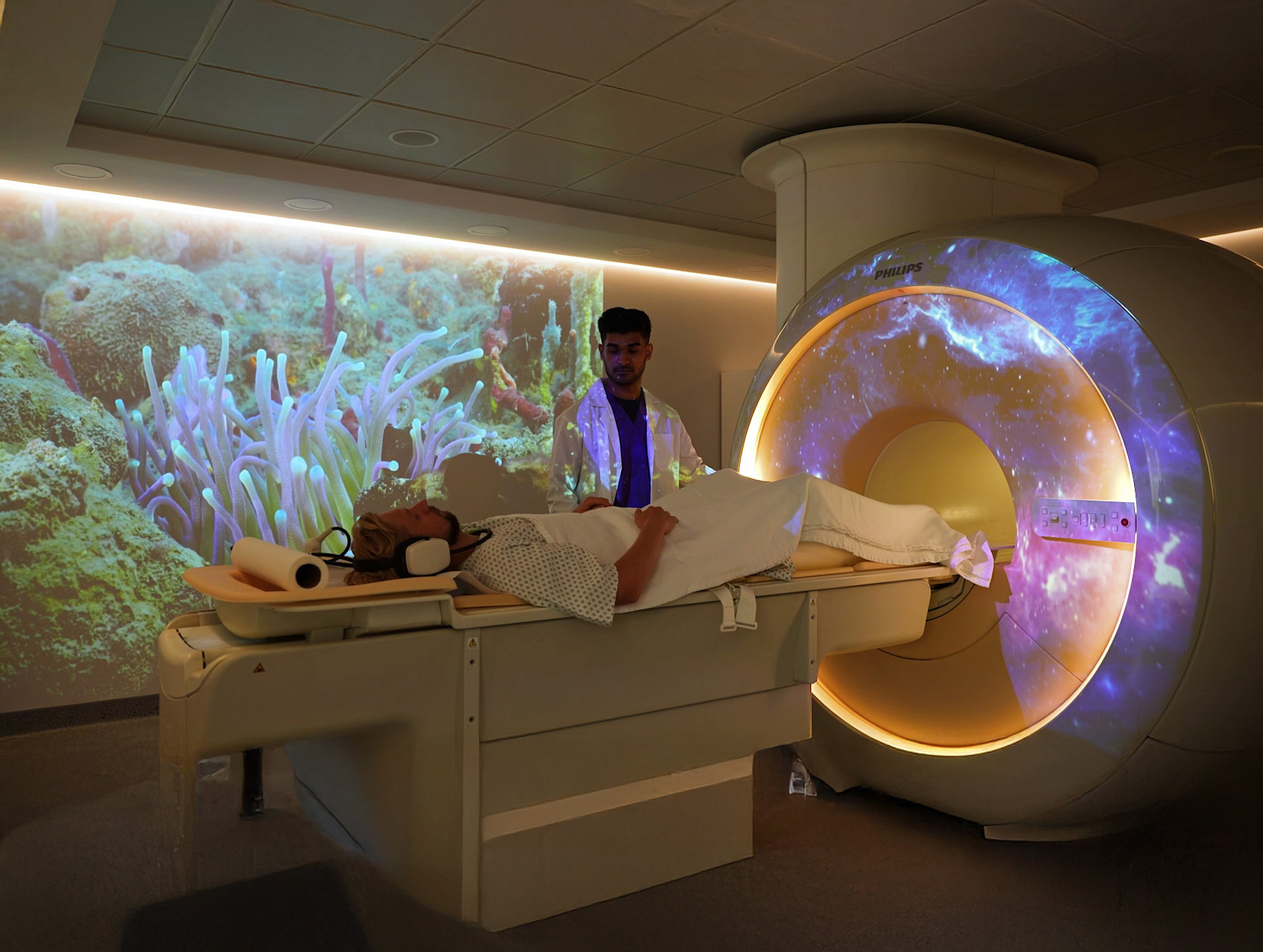MRI Diagnostics
Open and closed MRI scans — with or without contrast — in one clinic

Service provided by
All doctorsMRI Capabilities at Polyclinic.ae
Magnetic Resonance Imaging (MRI) is a modern, accurate, and completely safe diagnostic method that provides layered, high-resolution images of internal organs, joints, blood vessels, and soft tissues. At Polyclinic.ae, we perform all major types of MRI scans using both closed (1.5 Tesla) and open (0.5 Tesla) systems.
- The only Russian-speaking clinic in Dubai offering the full range of MRI services
- Expert-grade equipment, warm atmosphere, and attentive staff
- Fast, convenient, no waiting lists, under the supervision of experienced Russian-speaking doctors
What You Need for an MRI
- Referral from a Polyclinic.ae doctor or any external specialist
- Advance booking required (by phone, online, or through reception)
- For MRI with contrast, your doctor will assess medical indications and necessity before the procedure
Why Choose MRI at Polyclinic.ae
- Open and closed MRI scanners — we select the best option based on your case
- All in one place: consultation, imaging, and radiologist report
- Experienced specialists and detailed medical protocols
- Russian-speaking assistance throughout your visit
- High-resolution scanners for maximum diagnostic accuracy
MRI Scan Areas
At Polyclinic.ae, we perform all key MRI examinations using advanced equipment for precise and safe diagnostics.
Brain and Neck MRI
Recommended for headaches, dizziness, numbness, vision or hearing problems, and coordination issues. Detects tumors, aneurysms, multiple sclerosis, stroke, neuralgia, and inflammation. Neck MRI evaluates blood vessels, lymph nodes, thyroid, larynx, and soft tissues.
Spine MRI (Cervical, Thoracic, Lumbar)
Prescribed for back pain, numbness, or sensory disorders. Identifies herniated discs, protrusions, osteoarthritis, spinal stenosis, inflammation, and tumors. Often recommended for radiculopathy or spinal injuries.
Joint MRI
Used to diagnose injuries, chronic pain, or restricted mobility. We scan the knee, shoulder, hip, elbow, ankle, and wrist joints. Provides detailed visualization of ligaments, cartilage, tendons, and joint capsules.
Pelvic MRI
For women: recommended for pelvic pain, irregular cycles, suspected endometriosis, fibroids, or ovarian tumors.
For men: used to evaluate urinary symptoms, prostatitis, and prostate enlargement.
MRI clearly visualizes the uterus, ovaries, prostate, bladder, and rectum.Abdominal MRI
Comprehensive examination of the liver, pancreas, spleen, gallbladder, kidneys, and adrenal glands. Used for abdominal pain, digestive issues, abnormal test results, or suspected tumors, cysts, and inflammation. Contrast may be added when needed.
MR Angiography (Vascular MRI)
Visualizes brain, neck, and limb vessels to detect aneurysms, stenosis, thrombosis, or poor circulation. Can be performed with or without contrast. Especially useful for dizziness, numbness, or fainting.
MRI with Contrast
Enhances visualization of blood vessels, tumors, and inflammatory zones. Used when a more detailed diagnostic image is required — especially for cancer, CNS disorders, or metastasis screening.
MRI without Contrast
A safe and informative option for most cases. Used for initial diagnostics, pain evaluation, neurological symptoms, injuries, or chronic conditions.
MRI Contraindications
Open vs. Closed MRI
Frequently Asked Questions
- Is MRI covered by insurance?
-
Yes. MRI scans at Polyclinic.ae can be covered by your medical insurance, provided that:
- You have a valid referral from a Polyclinic.ae or external doctor
- Your insurance company is among our network partners (our team can verify this)
- Pre-approval is obtained, if required — our administrators handle this quickly and stress-free
Some basic insurance plans may not include MRI or only cover it partially. Send us a photo of your insurance card, and we’ll confirm your coverage immediately.
- When will I receive my MRI results?
-
The official radiologist report is typically ready within 24 hours. Your doctor will also review the findings with you during your follow-up visit.
- How quickly can I book an MRI? Are there waiting times?
-
Usually, you can schedule your MRI within 1–2 days after your doctor’s referral or insurance approval — sometimes even on the same day.
- Why is MRI not allowed for patients with pacemakers?
-
Non-MRI-compatible pacemakers may malfunction due to the magnetic field, which can be life-threatening. Always inform your doctor about any implants, stents, or metal fragments before the procedure.
- What should I remove before entering the MRI room?
-
- All metal objects: jewelry, watches, belts, pins, cards
- Phones, keys, eyeglasses, and credit cards
- Hearing aids, dentures, wigs with metal clips
- Makeup with metallic pigments (glitter, shimmer)
Each MRI suite has a private changing area where you can safely store your belongings.
- Are there weight or body size limits?
-
Yes:
- Closed MRI (1.5T) supports up to 120–130 kg
- Open MRI (0.5T) is more accommodating for larger body types and patients with claustrophobia
Our staff will always select the most comfortable and suitable option for you. - How is MRI different from CT or Ultrasound?
-
- MRI: best for soft tissues, brain, vessels, joints, and gynecological organs
- CT: better for bones, lungs, and trauma cases
- Ultrasound: fast and affordable, but limited in depth and tissue detail
MRI provides the most comprehensive and accurate view, especially in complex or unclear medical cases. - How do I know if I need contrast?
-
Your doctor decides based on your diagnosis. Contrast is used to highlight blood vessels, tumors, and inflammation. Most standard scans (brain, spine, joints) are done without contrast. For contrast MRI, we always check kidney function and evaluate any risks in advance.
- Is MRI safe?
-
Yes. MRI uses magnetic fields, not radiation, making it completely safe — even for children and, in later pregnancy stages, for expectant mothers (under medical supervision).
- Can I scan multiple areas at once?
-
Yes, your doctor can request multiple regions — for example, a lumbar spine and hip MRI. We’ll plan your session to ensure maximum comfort and diagnostic precision.
- How long does an MRI take?
-
Typically 15–45 minutes, depending on the area and whether contrast is used.
Approximate durations:- Brain MRI — 25 minutes
- Knee MRI — 20 minutes
- Do I need a referral for an MRI?
-
Yes. MRI is a complex diagnostic method that must be prescribed by a doctor who defines the target area and need for contrast. You can obtain a referral at Polyclinic.ae or bring one from your physician.
- Can I bring a referral from another clinic?
-
Absolutely. We accept referrals from external specialists, provided they specify the examination area and purpose (e.g., “Lumbar spine MRI for lower back pain”).
- Do you perform MRI with contrast? How is it done?
-
Yes. The contrast agent is administered intravenously after assessing kidney function and ruling out allergies. The scan itself is safe and painless. Afterward, you’ll remain under observation for 15–20 minutes.
- What’s the difference between open and closed MRI?
-
- Closed MRI: traditional tunnel-type scanner with the highest image precision
- Open MRI: open sides for comfort — ideal for claustrophobic patients and children, though less detailed for deep organs like the brain
- How much does an MRI cost?
-
MRI prices typically start from AED 2,000–3,000, depending on the area and whether contrast is used. We frequently offer promotional packages and discounts — please check our current offers.
- Does MRI replace gastroscopy or colonoscopy?
-
No. Those procedures visualize the inner lining of the digestive tract, while MRI provides anatomical imaging of deeper structures. They complement each other rather than substitute one another.


